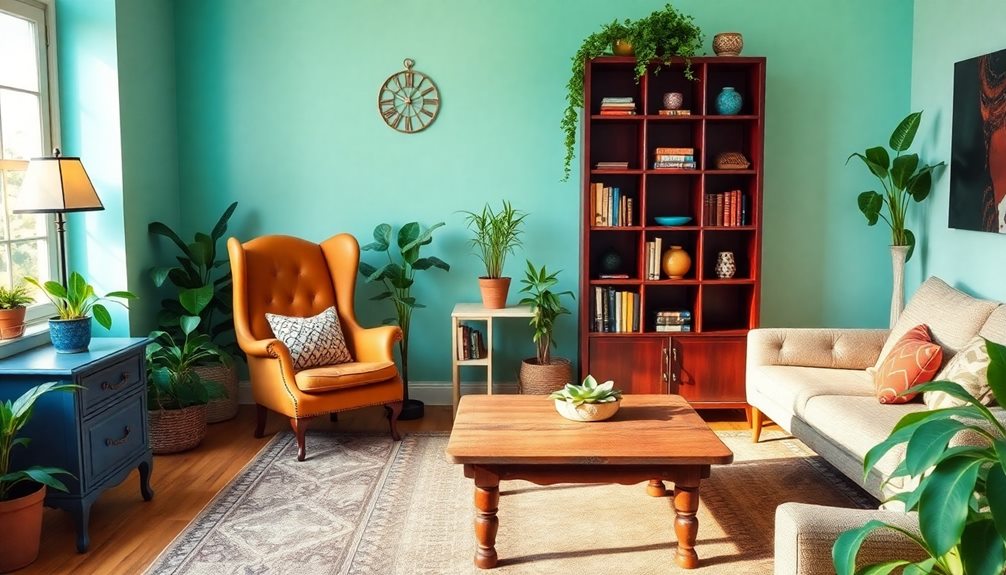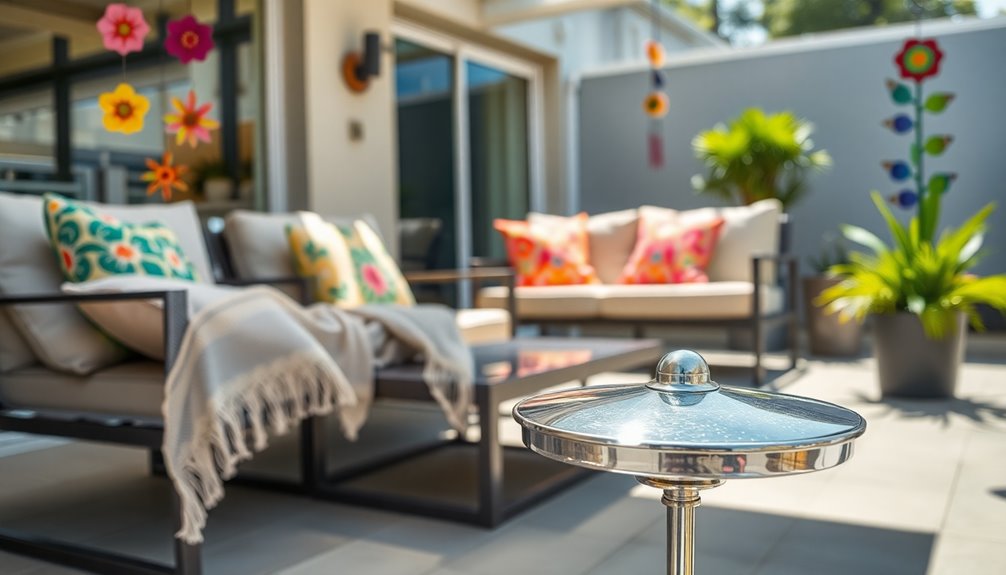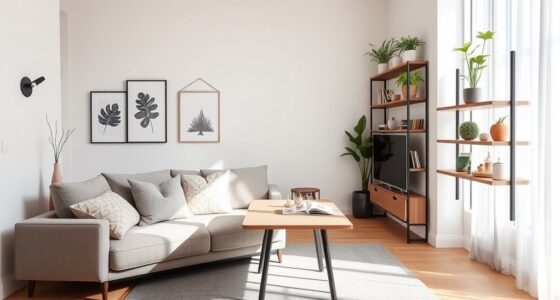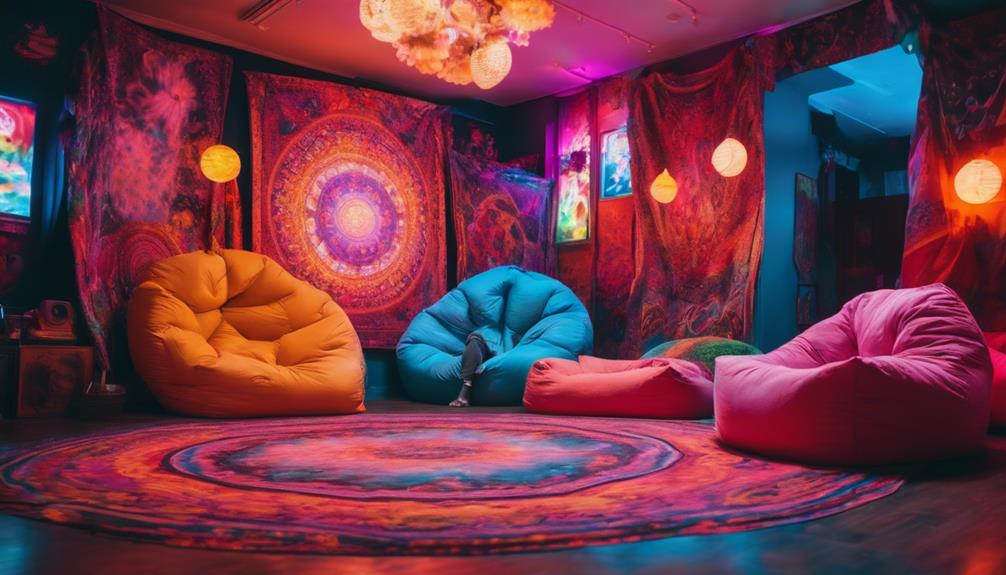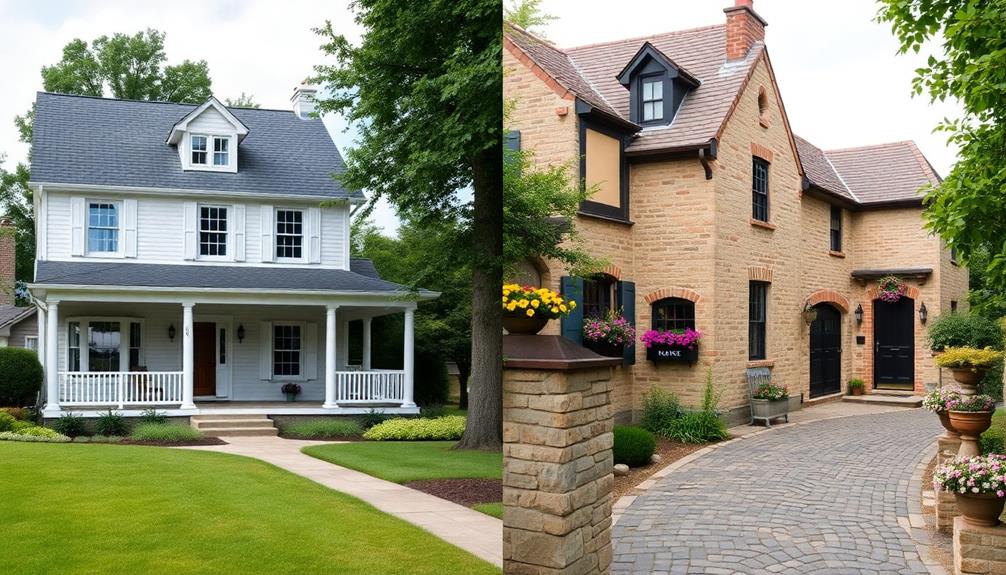Transforming secondhand furniture is a fulfilling DIY project that can elevate the look of your home while also being cost-effective. Begin by inspecting items that have a sturdy structure and then clean and evaluate their overall condition. Be sure to have necessary tools for refinishing, such as sandpaper and paint, and select a design that complements your personal style. Think about updating upholstery for a modern twist and consider adding decorative hardware for added visual appeal. Consistent upkeep is vital in maintaining the condition of your refurbished pieces. By combining creativity with proper techniques, you can achieve remarkable makeovers that showcase your individuality—there is always more to explore in attaining the perfect final touch!
Key Takeaways
- Evaluate and clean thrifted furniture before starting any transformation to ensure a solid foundation for your project.
- Plan your design and color scheme in advance to align with your existing decor and personal style.
- Use sanding and painting techniques to refresh surfaces, applying primer for better paint adhesion.
- Update upholstery with trendy fabrics, adding foam padding for comfort, and secure with staples for a professional finish.
- Enhance aesthetics by upgrading hardware and incorporating decorative elements for a personalized touch.
Benefits of Second-Hand Furniture
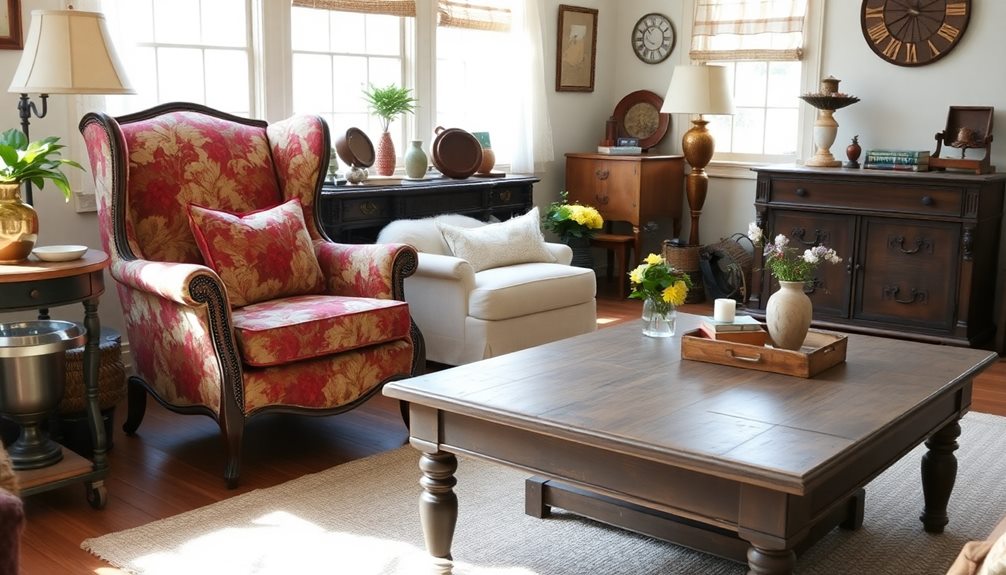
When it comes to furnishing your home, many people find that second-hand furniture offers a wealth of benefits. First off, it's a cost-effective choice, allowing you to save up to 70% compared to new items. This means you can stretch your budget further while still creating a stylish space.
Additionally, investing in quality second-hand furniture can lead to long-term savings on energy bills, as it can often help create a more energy-efficient home environment, similar to the benefits of energy-efficient heat pumps.
Thrifted furniture often features unique styles and craftsmanship that can't be found in mass-produced pieces. This individuality adds character to your home and helps set it apart from the crowd.
You'll also be investing in high-quality materials; older furniture is typically made from solid wood, providing durability and longevity that many modern alternatives simply can't match.
Moreover, choosing second-hand pieces contributes to sustainability efforts. By purchasing used furniture, you're helping reduce the staggering 12 million tons of furniture that end up in landfills each year in the U.S.
Preparing for Your Project
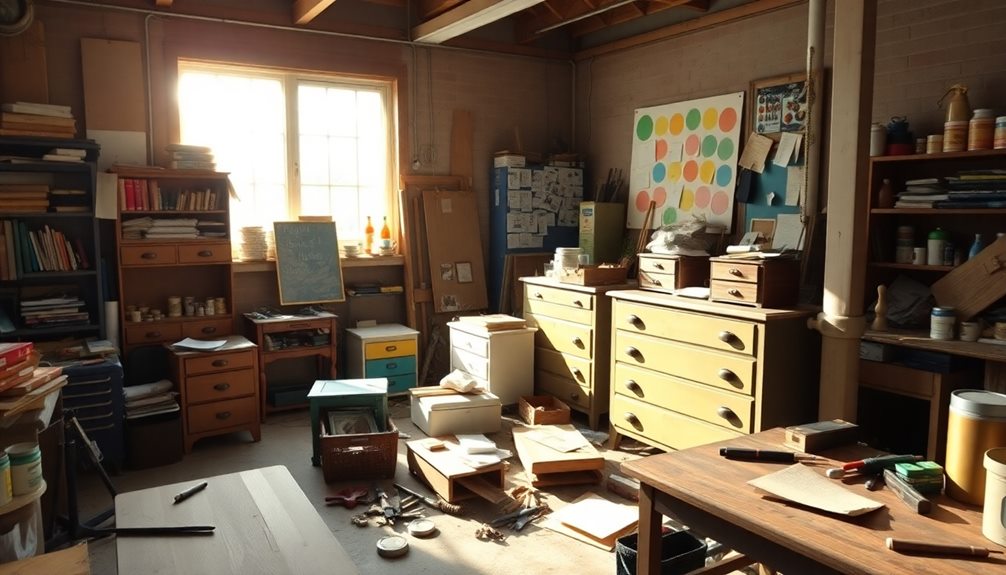
How can you guarantee a successful transformation of your thrifted furniture? Start by thoroughly evaluating the condition of your piece. Identify any necessary repairs to ensure structural integrity before diving into the fun parts.
Once you know what needs fixing, get started on cleaning. Use a gentle cleaning solution to remove dirt and grime, creating a smooth surface for painting.
Next, gather all essential tools—sandpaper, paint, brushes, wood filler, and any hardware you might need. Having everything on hand will streamline your process and help you avoid unnecessary trips to the store.
Choose a suitable workspace, preferably a well-ventilated area. This won't only keep the mess contained but also allow for proper drying of your paints and finishes.
Lastly, plan your design and color scheme in advance. Consider how it aligns with your existing decor and personal style preferences.
Techniques for Refinishing
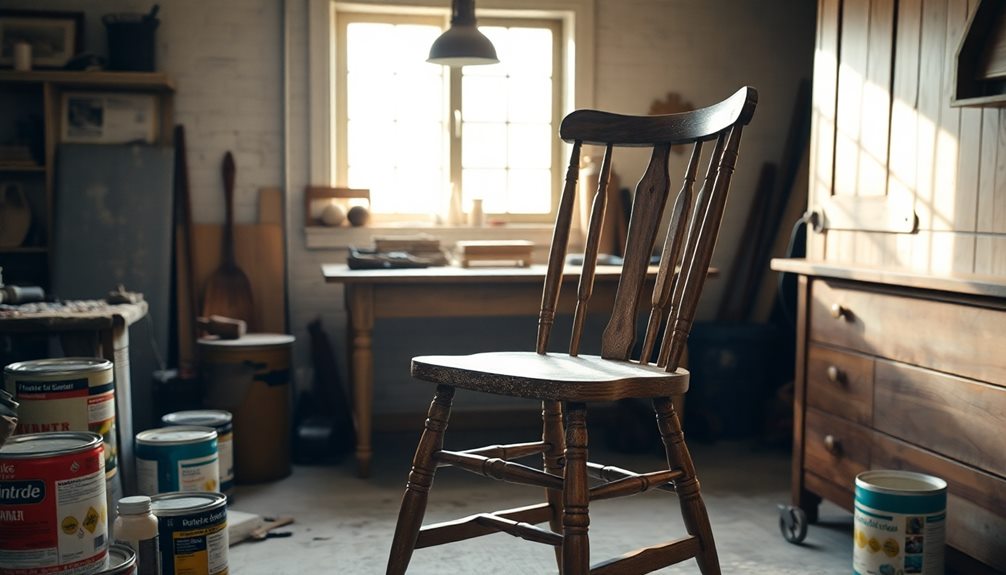
Refinishing thrifted furniture involves several key techniques that can elevate your piece from worn to wonderful.
Start with good cleaning to remove dirt and grease, ensuring a solid base for your furniture makeover.
Next, sand the surfaces thoroughly. Begin with coarse-grit sandpaper (80-120 grit) to tackle rough patches, then switch to finer grit (220-320 grit) for a polished finish.
Applying primer is essential for better paint adhesion, especially on porous or previously finished surfaces. Choose a primer that complements your paint type, like Chalk Paint for that beautiful matte look.
Once primed, select your paint; acrylic can provide durability, while Chalk Paint offers a soft, vintage vibe.
For a personal touch, consider experimenting with stencils or decals to create unique design elements.
After painting, don't forget to install new hardware to modernize the piece.
Upholstery and Fabric Updates
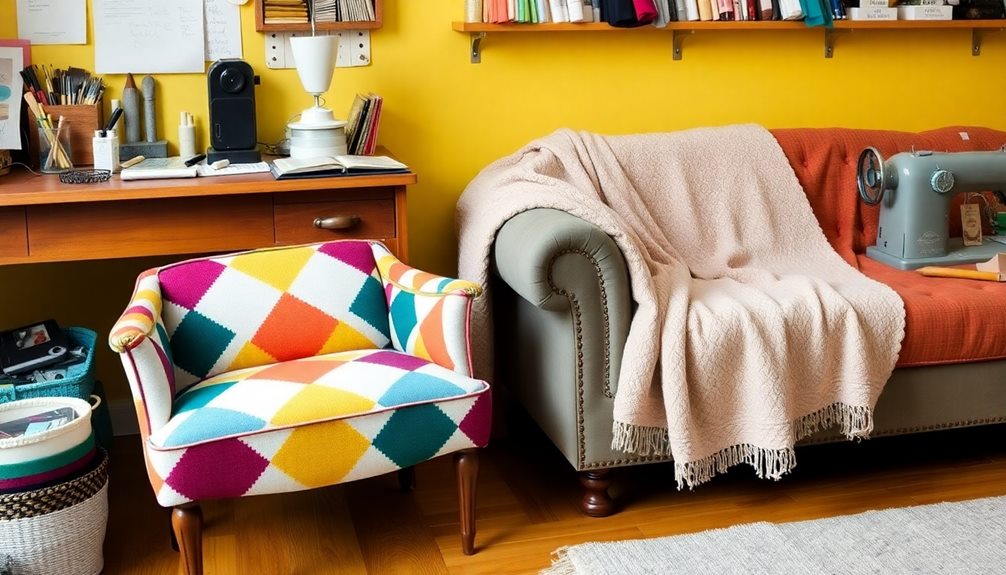
Updating upholstery can breathe new life into thrifted furniture, transforming it into a stunning focal point in your home. Choosing the right fabric is essential; trendy velvet or durable linen can elevate your piece while enhancing comfort. Start by carefully removing the old upholstery to preserve the frame, ensuring the new fabric fits perfectly around the contours.
Here's a quick overview of your options:
| Fabric Type | Benefits |
|---|---|
| Velvet | Luxurious look, soft feel |
| Linen | Durable, easy to clean |
| Cotton Blend | Versatile, breathable |
To improve comfort, consider adding foam padding before applying the new fabric. Securely staple or sew the fabric onto the frame, paying extra attention to corners and edges for a professional finish. Don't forget to incorporate decorative elements like piping or buttons; they can add sophistication and charm to your revamped furniture. With the right choices and techniques, you'll create a beautiful and inviting piece that complements your decor perfectly.
Final Touches and Maintenance
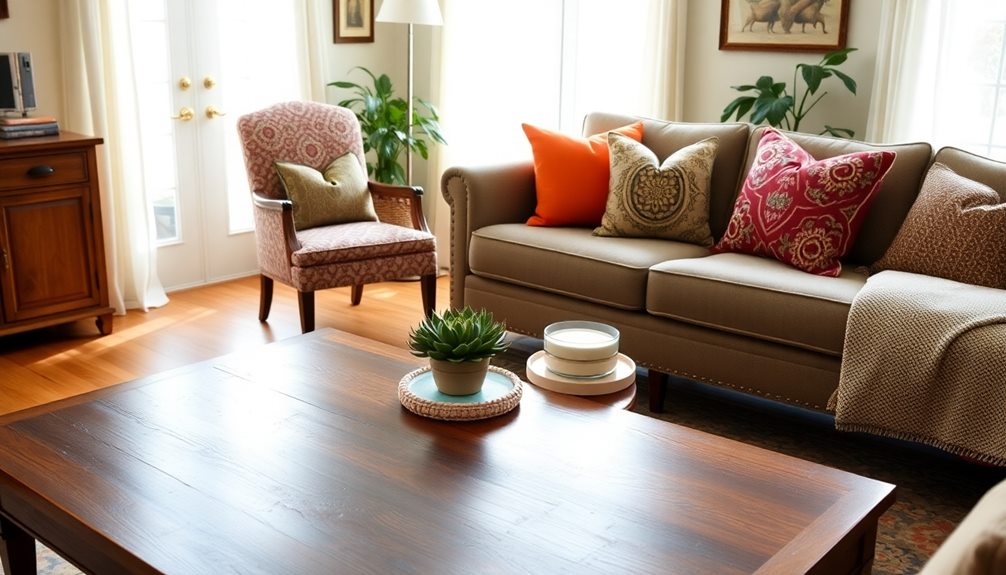
To really bring your thrifted furniture to life, consider adding decorative hardware like new knobs and handles.
Utilizing aesthetic hooks and wall organization can also complement your transformed pieces by enhancing vertical space and reducing clutter.
You'll want to keep it looking fresh, so establish a routine for cleaning and inspecting for any wear and tear.
These final touches not only enhance the piece but also guarantee it lasts for years to come.
Adding Decorative Hardware
Transforming thrifted furniture isn't complete without adding decorative hardware, which can greatly elevate its visual appeal. Upgrading hardware, like knobs and handles, dramatically enhances the overall aesthetic, giving your vintage pieces a modern touch.
When you select new hardware, consider materials such as brass or matte black; these options add a contemporary feel and visual interest to your furniture. Additionally, choosing a vacuum designed for pet hair can help maintain the cleanliness of your newly transformed pieces, guaranteeing they remain stunning for years to come. Best vacuums for pet hair will effectively tackle any messes while preserving the integrity of your furniture.
Before making a purchase, measure the existing holes to confirm that your new hardware fits properly. This attention to detail will help you achieve a polished look that aligns with your design vision.
Additionally, don't hesitate to incorporate decorative elements like stencils or decals. These can further personalize your furniture, allowing for unique expressions of style that beautifully complement the new hardware.
Routine Cleaning Practices
Maintaining the beauty of your thrifted furniture is essential for ensuring it lasts and continues to impress. Start with routine cleaning by regularly dusting surfaces using a microfiber cloth to remove dirt and prevent build-up. This simple practice keeps your furniture looking clean and fresh.
For any accidental stains, use a gentle cleaning solution mixed with water to spot clean, but remember to test it on a small, inconspicuous area first to avoid damage.
Every 3-6 months, apply a coat of furniture wax to protect the finish and enhance shine, especially on painted or stained surfaces. This will help combat wear and tear over time, keeping your piece in top condition.
If you have upholstered furniture, vacuum it regularly to remove debris and consider using fabric protectors to shield against spills and stains. If a spill occurs, address it immediately by blotting the area gently with a clean, absorbent cloth to prevent the stain from setting. For more stubborn stains, always check the manufacturer’s care instructions before using any cleaning products to avoid damaging the fabric. When cleaning a white sofa effectively, opt for mild cleaning solutions and test them on a hidden area first to ensure they don’t cause discoloration.
Periodic Inspection Tips
Regular inspections of your thrifted furniture are key to catching potential issues before they escalate. Aim for a periodic inspection every 6-12 months to check for signs of wear and tear like loose joints, scratches, or fading paint.
Look closely for any signs of damage, such as cracks in wood or fraying fabric, and address these issues promptly to prevent further deterioration.
During your inspection, clean surfaces with appropriate cleaning solutions to maintain their appearance and eliminate dirt buildup. This not only keeps your furniture looking fresh but also helps extend its lifespan.
After cleaning, consider applying furniture wax or a protective topcoat annually. This enhances durability and guards against scratches and stains.
Don't forget to document any changes or repairs made during your inspections. Keeping a record of your maintenance history helps you track the condition of your furniture over time and informs future care decisions.
Inspiring Before and After Transformations
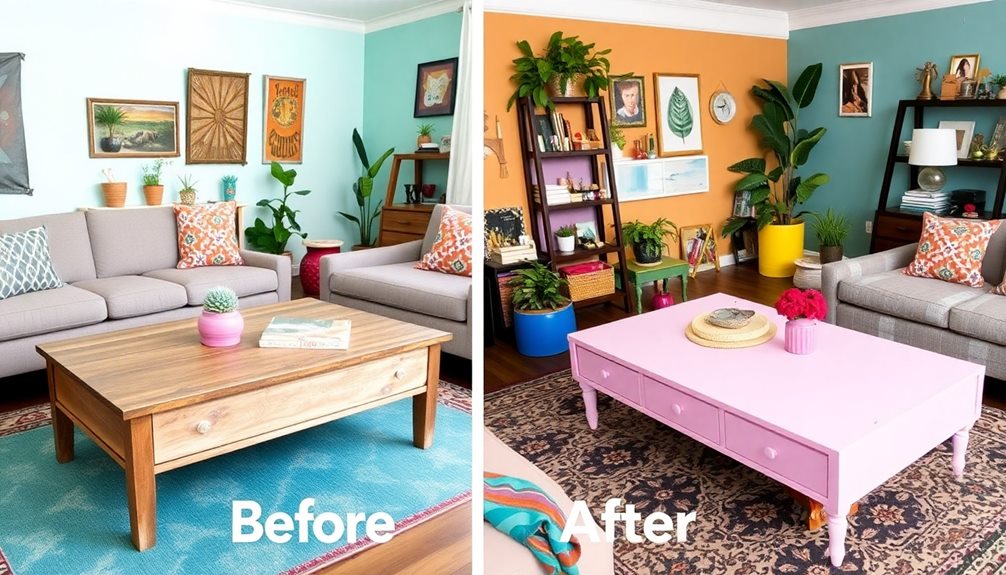
When you tackle a thrifted furniture transformation, it's all about the process and the inspiration behind it.
You can turn a worn-out piece into something stunning with just a few techniques and creative ideas.
Let's explore how design sources can spark your imagination and guide your own before and after projects.
Transformation Process Overview
Transforming thrifted furniture can breathe new life into your space, and the results are often stunning. The transformation process begins with identifying pieces that have good bones—those solid structures that just need a little love.
For instance, a traditional chest can be revamped from a dated style to a modern industrial look with some creative refinishing techniques.
You don't have to break the bank, either. Investing around $80, combining a $40 purchase and $40 in materials, showcases the cost-effectiveness of upcycling thrifted items compared to buying new furniture.
Start by applying a fresh coat of paint, like chalk paint, to give your piece a fresh vibe. Using gel stains can further enhance the look, allowing for personalized designs that reflect your unique style.
Additionally, consider sourcing unique hardware, such as knobs from specialized suppliers, to dramatically alter your furniture's character.
Documenting your before and after transformations not only serves as inspiration for your own projects but can also motivate others to explore the rewarding world of thrifted furniture upcycling.
Design Inspiration Sources
Finding design inspiration for your thrifted furniture transformations can be an exciting journey. With the right resources, you can turn any secondhand furniture piece into a stunning centerpiece.
Here are three amazing sources to ignite your creativity:
- Online Platforms: Explore Pinterest and Instagram for enchanting before and after transformations. You'll find countless examples of painted furniture that can spark ideas for your own projects.
- Local Thrift Stores and Flea Markets: Visit these spots regularly to discover unique pieces. Sometimes, a forgotten item can inspire a whole new design concept that you hadn't considered before.
- DIY Bloggers and YouTube Channels: Following dedicated furniture upcycling influencers can provide you with step-by-step guides and innovative techniques. Their transformations often highlight new trends and methods you can apply to your own pieces.
Lastly, don't overlook home decor magazines and websites. They're rich in aesthetic inspiration, showcasing color palettes and styles that can breathe new life into your thrifted finds.
With these sources, your journey into furniture transformation will surely be a rewarding one!
Cost-Effective Furniture Solutions
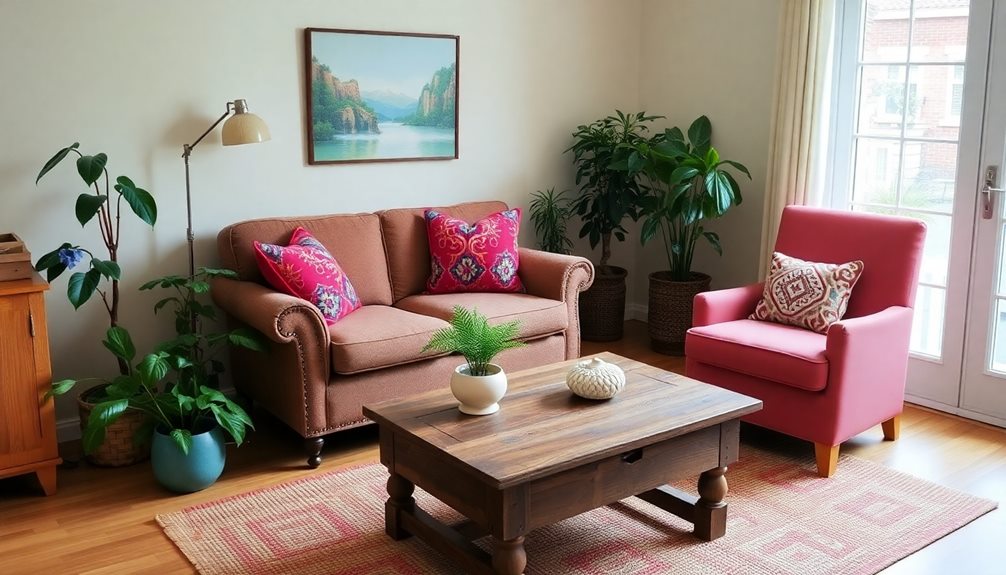
Thrifted furniture presents an unbeatable cost-effective solution for budget-conscious shoppers, with many quality pieces priced between $20 and $100. Investing in second-hand furniture not only saves you money but also promotes sustainability by reducing waste and the carbon footprint associated with manufacturing new items.
By upcycling thrifted pieces, you can personalize your space without the hefty price tag of custom furniture. Plus, many thrift stores and charity shops often have sales or discounts, giving you the chance to snag unique items at even lower prices.
Here's a quick comparison of potential savings:
| Item Type | Thrifted Price | New Price |
|---|---|---|
| Coffee Table | $30 | $150 |
| Dining Chair | $20 | $75 |
| Bookshelf | $40 | $120 |
| Sofa | $100 | $500 |
| Nightstand | $25 | $80 |
Incorporating thrifted furniture into your home is a smart, stylish, and eco-friendly approach. With a little creativity, you can create an inviting space without breaking the bank. So, start exploring your local thrift stores today!
Frequently Asked Questions
How Do I Choose the Right Thrift Store for Furniture Finds?
To choose the right thrift store for furniture finds, visit multiple locations, check their inventory regularly, and look for stores with a good reputation. You'll discover unique pieces that fit your style and budget.
What Tools Are Essential for a Furniture Transformation Project?
Transforming furniture is like crafting a masterpiece; you need essential tools. Grab a sander, paintbrush, scissors, a drill, and a good measuring tape. With these, you'll turn your vision into reality and elevate your space!
How Can I Assess the Quality of Thrifted Furniture?
To assess the quality of thrifted furniture, check for sturdy construction, inspect joints for stability, and look for signs of wear. Ascertain surfaces are intact, and smell for any unusual odors that might indicate damage.
What Safety Precautions Should I Take While Refinishing Furniture?
When refinishing furniture, wear a mask to avoid inhaling dust and fumes, use gloves to protect your skin, and work in a well-ventilated area. Always read product labels for specific safety instructions.
Can I Mix Different Furniture Styles in My Home Decor?
Mixing different furniture styles can create a unique and dynamic space. Think of it as blending flavors in a dish—each piece adds its own character, enhancing your home's personality and charm. Don't be afraid to experiment!
Conclusion
In transforming thrifted furniture, you not only breathe new life into forgotten pieces but also embrace sustainability. This practice challenges the theory that new is always better; in fact, with a little creativity and effort, second-hand finds can rival modern designs. By following the steps outlined in this guide, you can create unique, stylish pieces that reflect your personality while being kind to the planet. So jump in—your next favorite furniture piece is just a makeover away!
